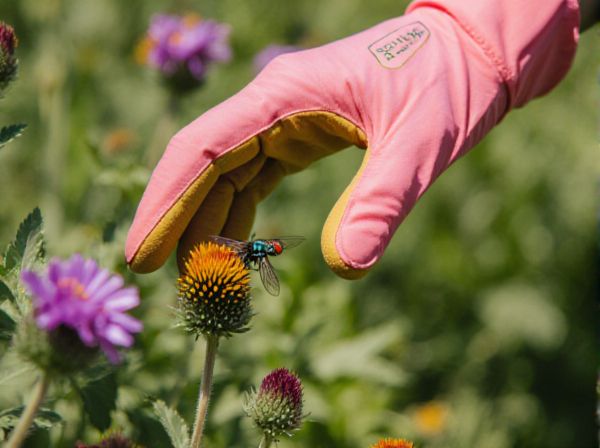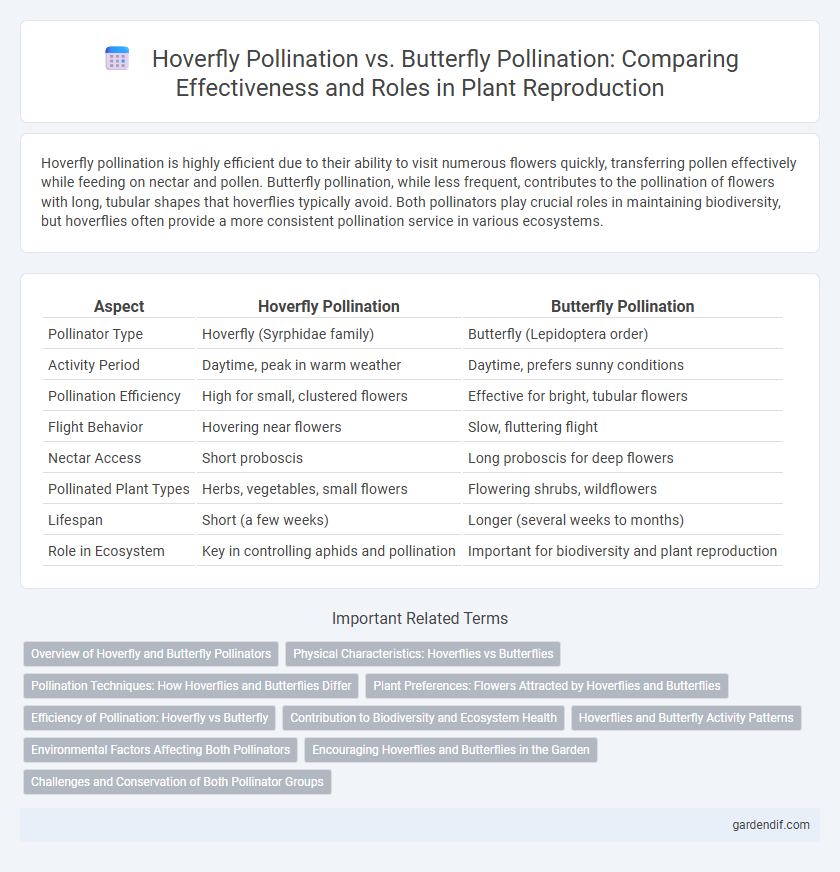
Hoverfly Pollination vs Butterfly Pollination Illustration
Hoverfly pollination is highly efficient due to their ability to visit numerous flowers quickly, transferring pollen effectively while feeding on nectar and pollen. Butterfly pollination, while less frequent, contributes to the pollination of flowers with long, tubular shapes that hoverflies typically avoid. Both pollinators play crucial roles in maintaining biodiversity, but hoverflies often provide a more consistent pollination service in various ecosystems.
Table of Comparison
| Aspect | Hoverfly Pollination | Butterfly Pollination |
|---|---|---|
| Pollinator Type | Hoverfly (Syrphidae family) | Butterfly (Lepidoptera order) |
| Activity Period | Daytime, peak in warm weather | Daytime, prefers sunny conditions |
| Pollination Efficiency | High for small, clustered flowers | Effective for bright, tubular flowers |
| Flight Behavior | Hovering near flowers | Slow, fluttering flight |
| Nectar Access | Short proboscis | Long proboscis for deep flowers |
| Pollinated Plant Types | Herbs, vegetables, small flowers | Flowering shrubs, wildflowers |
| Lifespan | Short (a few weeks) | Longer (several weeks to months) |
| Role in Ecosystem | Key in controlling aphids and pollination | Important for biodiversity and plant reproduction |
Overview of Hoverfly and Butterfly Pollinators
Hoverflies, belonging to the Syrphidae family, are efficient pollinators renowned for their ability to hover and their attraction to a wide range of flowers, particularly those with open and easily accessible nectar. Butterflies, from the order Lepidoptera, exhibit strong flower fidelity and prefer brightly colored blooms with landing platforms, contributing to selective pollination processes. Both hoverflies and butterflies play essential roles in ecosystems by enhancing plant reproduction, but hoverflies tend to visit flowers more frequently, while butterflies often facilitate cross-pollination over longer distances.
Physical Characteristics: Hoverflies vs Butterflies
Hoverflies, characterized by their compact bodies and rapid wing beats, possess large compound eyes and short antennae that enhance their flight agility and pollination efficiency. In contrast, butterflies feature elongated wings, slender bodies, and clubbed antennae, which facilitate gliding flight but slower movement between flowers. These physical differences influence their pollination roles, with hoverflies capable of hovering mid-air to access nectar precisely, while butterflies rely on landing on flowers to feed.
Pollination Techniques: How Hoverflies and Butterflies Differ
Hoverflies use rapid, hovering flight to access nectar while simultaneously collecting pollen on their bodies, facilitating efficient pollination through direct flower contact. Butterflies rely on their long proboscis to reach nectar deep within flowers, often resulting in less pollen transfer as their bodies make limited contact with reproductive structures. This difference in pollination techniques affects plant species specialization, with hoverflies typically pollinating open, shallow flowers and butterflies favoring tubular, nectar-rich blossoms.
Plant Preferences: Flowers Attracted by Hoverflies and Butterflies
Hoverflies are primarily attracted to flowers with easily accessible nectar such as umbellifers, daisies, and composites, favoring open, shallow blossoms that allow them to land and feed efficiently. Butterflies prefer brightly colored flowers with tubular shapes, such as milkweed and lantana, which accommodate their long proboscis for nectar extraction. Both pollinators contribute to plant reproduction by targeting different floral structures, enhancing biodiversity through varied pollination patterns.
Efficiency of Pollination: Hoverfly vs Butterfly
Hoverflies exhibit higher pollination efficiency compared to butterflies due to their ability to visit a larger number of flowers in a shorter time and their hairy bodies, which enhance pollen transfer. Butterflies, while effective in pollination, tend to have longer probing times per flower and less pollen adherence, reducing their overall pollination rate. Studies show hoverflies contribute significantly to crop pollination, especially in temperate regions, highlighting their critical role in ecosystem services.
Contribution to Biodiversity and Ecosystem Health
Hoverfly pollination significantly enhances biodiversity by supporting a wide range of flowering plants due to their ability to visit various habitats and flower types, which promotes genetic diversity and ecosystem resilience. Butterflies contribute to ecosystem health through their selective pollination of specific plant species, aiding in the reproduction of plants that form crucial components of local food webs. Together, these pollinators facilitate plant diversity and stability in ecosystems, sustaining habitats for numerous other organisms.
Hoverflies and Butterfly Activity Patterns
Hoverflies exhibit high activity during daylight hours, particularly in open, sunny environments, which aligns closely with the peak flowering times of many plants they pollinate. Butterflies also prefer sunny conditions but tend to have a broader range of activity extending into later afternoon periods, contributing to pollination across different time frames. The diurnal patterns of hoverflies often result in more consistent and frequent visits to flowers compared to butterflies, enhancing their effectiveness as pollinators.
Environmental Factors Affecting Both Pollinators
Hoverfly pollination thrives in cooler, shaded environments with abundant moisture, while butterfly pollination is more effective in sunny, open habitats with warm temperatures. Hoverflies are highly sensitive to pesticide exposure and habitat fragmentation, which reduce their population density. Butterflies face challenges from decreased floral diversity and climate change, impacting their foraging behavior and migration patterns.
Encouraging Hoverflies and Butterflies in the Garden
Hoverflies contribute significantly to pollination by visiting a wide range of flowers, especially those with open, flat blossoms, while butterflies prefer brightly colored, tubular flowers that provide nectar. Encouraging hoverflies involves planting herbs like dill, fennel, and coriander, which attract their larvae that prey on aphids, enhancing natural pest control. To attract butterflies, cultivate nectar-rich plants such as milkweed, butterfly bush, and coneflower, creating a habitat that supports their life cycle and maximizes garden biodiversity.
Challenges and Conservation of Both Pollinator Groups
Hoverfly pollination faces challenges such as habitat loss and pesticide sensitivity, while butterfly pollination is threatened by climate change and fragmented landscapes. Conservation efforts for hoverflies include creating flower-rich habitats and reducing chemical usage, whereas butterfly conservation focuses on preserving host plants and migration corridors. Both groups require targeted strategies to maintain biodiversity and ecosystem services vital for pollination.
Hoverfly Pollination vs Butterfly Pollination Infographic

 gardendif.com
gardendif.com